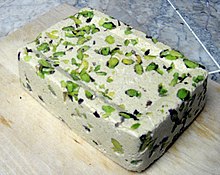
Halvaa (Pärsiaes حلوا ḩalva)[1][2] on idamaist päritolu maius, mis on valmistatud suhkrust ja pähklitest või seemnetest.
Pildirida
- ↑ Marks, Gil (17. november 2010). Encyclopedia of Jewish Food (inglise). HMH. ISBN 978-0-544-18631-6.
Halva is a dense confection. The original type is grain based, typically made from semolina, and another kind is seed based, notably made from sesame seeds. Origin: Persia
- ↑ Foundation, Encyclopaedia Iranica. "Welcome to Encyclopaedia Iranica". iranicaonline.org (Ameerika inglise). Vaadatud 23. aprillil 2021.
The origin of ḥalwā in Persia dates from the pre-Islamic period. References are found in the Middle Persian text of Xōsrōv ud rēdak (ed. Monchi-zadeh, secs. 38-40) to two kinds of sweetmeats (rōγn xwardīg): (1) summer sweetmeats, such as lōzēnag (made with almond), gōzēnag (made with walnut), and čarb-angušt (made from the fat of bustard or gazelle and fried in walnut oil); and (2) winter sweetmeats, such as wafrēnagītabarzad flavored with coriander (gišnīz ačārag). Many references are found to ḥalwā in classical Persian texts, but rarely do they provide details concerning ingredients.















You must be logged in to post a comment.